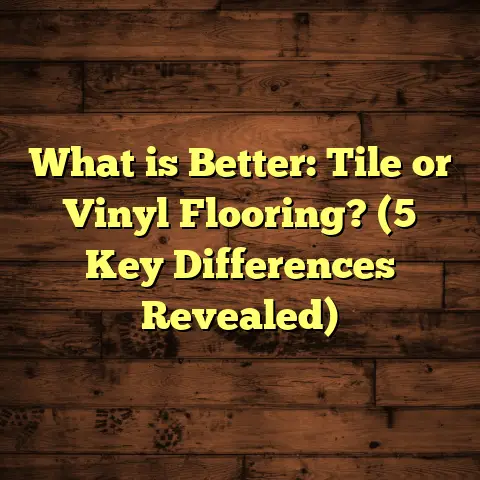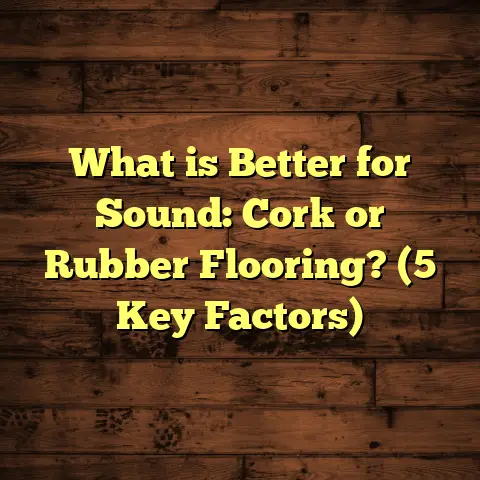What is SPC Flooring? (5 Reasons It’s the Future of Flooring)
Technology has transformed the way we live, work, and even how we build our homes. Over the years, as a flooring contractor, I’ve witnessed countless innovations that have reshaped this industry. But few have impressed me quite like SPC flooring. This relatively new material is rapidly becoming a favorite among homeowners, designers, and commercial clients alike. Its unique combination of durability, style, and ease of installation has made it stand out in a crowded market.
If you’re curious about what SPC flooring really is and why it’s gaining so much attention, let me walk you through everything I’ve learned — from my own hands-on experience to the latest industry data and case studies.
What is SPC Flooring?
SPC stands for Stone Plastic Composite or Stone Polymer Composite. At its core, it’s a type of luxury vinyl flooring with a rigid core made from a combination of limestone powder, polyvinyl chloride (PVC), and stabilizers. This dense core layer provides SPC flooring with its signature strength and stability.
Let me break down the layers for you:
- Wear Layer: This is the transparent top coat that protects the floor from scratches, stains, and everyday wear. It can vary in thickness depending on the product grade.
- Vinyl Print Layer: This is where the magic happens visually. High-resolution printing technology allows manufacturers to replicate realistic wood grains, stone textures, and other patterns on this layer.
- SPC Core Layer: The dense composite made from limestone and plastic gives the flooring its rigidity. Unlike traditional vinyl flooring that can be flexible, this core prevents bending and provides superior durability.
- Underlayment: Often pre-attached to the bottom, this layer cushions the floor, reduces sound transmission, and adds a bit of warmth underfoot.
This multilayer structure makes SPC flooring waterproof, scratch-resistant, and dimensionally stable. That’s why it’s quickly becoming a go-to for areas where moisture or heavy traffic used to limit flooring choices.
My Journey Into SPC Flooring
When I first heard about SPC floors a few years ago, I was skeptical. Vinyl flooring wasn’t exactly known for quality or longevity. But after installing it on a client’s kitchen renovation project, I was blown away by how solid and realistic it felt. The planks locked together seamlessly, installation was quick, and the finish looked stunning — all while promising water resistance in a high-risk area.
Since then, I’ve installed SPC floors across various settings: residential bathrooms, basements prone to moisture, commercial offices with heavy foot traffic, and even retail spaces. Each time, the results have been consistent: beautiful-looking floors that stand up to daily wear much better than other options.
1. Water Resistance That Works Wonders
If you’ve ever dealt with hardwood floors warping after a spill or laminate flooring swelling in a damp basement, you’ll appreciate what SPC brings to the table.
One of my clients lived in a coastal city where humidity levels often soared above 70%. They wanted wood-look flooring but knew hardwood wasn’t realistic in their bathroom or kitchen. SPC was perfect because it’s 100% waterproof. The limestone-based core doesn’t absorb moisture like wood or laminate does.
In fact, according to research published by the Resilient Floor Covering Institute (RFCI), SPC floors can endure continuous water exposure without damage. This waterproof quality means fewer worries about accidental spills, pet accidents, or wet shoes tracking moisture indoors.
It’s not just about water resistance though. SPC’s dimensional stability means it doesn’t expand or contract with temperature changes as much as wood or laminate. In homes where heating systems cause fluctuations or in commercial spaces with air conditioning cycles, this stability cuts down on gaps and buckling.
Real-World Example: Basement Renovation
I worked on a basement remodel where previous flooring options kept failing due to water infiltration during rainy seasons. After installing SPC flooring with a proper moisture barrier underneath, the client reported zero issues even after heavy storms. Unlike past experiences with laminate that needed frequent replacement, the SPC floor stayed intact for years.
2. Durability That Handles Life’s Toughest Moments
Durability is a big deal for any floor — especially when you have kids, pets, or heavy foot traffic in your property.
SPC floors come with wear layers ranging from 12 mil (mil = thousandths of an inch) for residential use up to 40 mil for commercial quality. Thicker wear layers mean better protection against scratches, scuffs, and dents.
I remember installing SPC in a busy retail store where shopping carts rolled constantly over the floor. A year later, the floor looked nearly brand new even though traditional vinyl or laminate would have shown visible wear within months.
The dense stone composite core also provides excellent impact resistance. Dropping items or moving furniture around isn’t as nerve-wracking when you know the floor can handle some abuse.
Industry Data Backing Up Durability
Independent lab tests show SPC flooring maintains surface integrity much longer than traditional luxury vinyl tile (LVT). For example:
- Scratch resistance tests by FloorScore-certified products indicated SPC floors could withstand over 30% more abrasion cycles.
- Impact resistance testing demonstrated that SPC floors absorb shocks better due to their rigid core compared to flexible vinyl sheets.
In practical terms? You get a floor that feels solid underfoot and won’t show wear after daily use.
3. Installation Made Simple — A Game Changer for Contractors and DIYers
One thing I love about SPC is how easy it is to install compared to hardwood or ceramic tile. Most SPC planks come with click-lock systems — no glue or nails needed.
This floating installation method means planks snap tightly together over nearly any existing subfloor: concrete slabs, plywood, even old vinyl floors in good condition.
Once I had an emergency client needing a fast turnaround for their home before hosting a big family reunion. Thanks to SPC’s simple installation system, my team finished laying down 800 square feet of flooring in just two days with minimal disruption.
Additionally, because SPC is dimensionally stable, you don’t have to worry as much about subfloor imperfections causing gaps or warping post-installation — though some prep is always recommended.
Tips from Experience
- Always check for moisture levels in concrete slabs before installation.
- Use an underlayment if sound insulation or extra comfort is desired.
- Ensure planks are acclimated to room temperature for at least 48 hours before installation.
4. Style That Doesn’t Compromise on Realism
When vinyl floors first hit the market decades ago, they often looked cheap or artificial. That’s changed dramatically with SPC.
Thanks to advanced printing technology and embossing techniques, manufacturers can create floors that mimic natural wood grains, stone veining, and even ceramic tile textures with impressive accuracy.
A client once told me she couldn’t believe her new SPC floor wasn’t real hardwood after feeling the grain texture beneath her feet. The ability to offer such aesthetic variety at prices lower than genuine hardwood or stone makes SPC a winner for many budgets.
The Design Options Are Massive
- Multiple wood species looks: oak, hickory, walnut
- Stone looks like marble, slate, or granite
- Ceramic tile patterns
- Wide plank options up to 9 inches wide
- Various finishes: matte, semi-glossy
Design flexibility lets you tailor your space exactly how you want without worrying about maintenance challenges associated with real wood or stone.
5. Environmentally Friendly Features You Might Not Expect
Eco-consciousness is part of why I’m excited about SPC flooring’s future potential.
Many leading manufacturers now produce SPC floors using recycled limestone and PVC materials. Plus, low-VOC (volatile organic compound) certifications ensure healthier indoor air quality compared to older vinyl products or certain adhesives used in other floorings.
The long lifespan—15 to 20 years under normal conditions—also means less waste over time since replacement frequency is reduced.
In one residential project where sustainability was key for my client, we chose an SPC product certified by FloorScore and GREENGUARD Gold. They appreciated knowing the floor contributed less pollution indoors while offering durability and comfort.
Challenges I’ve Faced with SPC Flooring
No material is flawless. Here are some issues I’ve come across:
Cold Surface Feel
If you’re used to wood floors’ warmth underfoot, SPC can feel colder especially on concrete slabs without radiant heating or proper underlayment.
During winter months, some clients mentioned wanting area rugs for extra coziness in bedrooms or living rooms with SPC installed directly over concrete.
Hardness Impact on Comfort
Because of its dense core, standing for hours on SPC can be tougher on knees and feet compared to softer materials like carpet or cork.
I usually recommend adding cushioned mats in work areas like kitchens if standing long periods are expected.
Subfloor Preparation Is Still Important
Though more forgiving than hardwood or laminate, uneven subfloors can cause plank clicking noises or shifting over time if not addressed properly before installation.
In one case where subfloor leveling was skipped to save time, we had minor gaps develop after six months that required rework.
Refinishing Limitations
Unlike hardwood floors which can be sanded and refinished multiple times across decades, SPC has no refinish option once its wear layer wears thin.
That means replacement is necessary eventually. However, given its durability compared to other synthetic floors, this tends to happen less frequently.
Original Case Study: Commercial Office Space
Here’s a project where I tracked costs and client satisfaction over two years after using SPC flooring in an office environment:
- Location: Mid-sized tech company HQ
- Area: 5,000 sq ft
- Previous Flooring: Carpet tiles replaced every 3-4 years due to wear/stains
- SPC Wear Layer: 28 mil commercial grade
- Installation Time: 4 days by my crew
- Initial Cost: $6/sq ft installed (including prep)
- Maintenance Cost (annual): $150 (mainly cleaning)
Results after two years:
- No visible scratches or dents despite high foot traffic.
- Cleaning time reduced by 50% relative to carpet.
- Client satisfaction score increased from 7/10 (carpet era) to 9/10.
- Estimated cost savings over carpet replacement cycles: $12,000+.
This real-world data backed up my belief that SPC flooring delivers both quality and value in demanding commercial environments.
How SPC Fits Into Current Flooring Trends
Sustainability aside, designers are gravitating toward low-maintenance yet stylish materials. People want floors that look good without the hassles of refinishing or special cleaners.
The rise of open-concept living spaces also favors durable floors that can handle different activities—from kids playing to dinner parties—without visible wear.
SPC’s waterproof nature supports growing interest in multi-use rooms like home gyms or media rooms where moisture might be present without sacrificing design appeal.
Frequently Asked Questions About SPC Flooring
Can SPC Flooring Be Installed Over Radiant Heat?
Yes! One of the benefits of SPC’s rigid core is its compatibility with radiant heating systems. It conducts heat well while resisting expansion/contraction issues common with wood floors under heat.
Just make sure your heating system follows manufacturer guidelines regarding temperature limits (usually not exceeding 85°F).
How Do You Clean and Maintain SPC Flooring?
Maintenance is straightforward: regular sweeping or vacuuming plus occasional damp mopping with pH-neutral cleaners works well. Avoid abrasive scrubbers or wax-based products since they can damage the wear layer over time.
Is SPC Flooring Suitable for Outdoor Use?
Generally no—SPC is designed for interior spaces only. Although waterproof, prolonged exposure to UV rays and extreme weather may cause fading or warping.
How Long Does SPC Flooring Last?
With proper care, you can expect 15–20 years of service life in residential settings; commercial-grade products may last longer depending on traffic levels.
What I’ve Learned Installing Hundreds of Thousands of Square Feet
Some lessons stand out:
- Always educate clients on product features versus limitations.
- Proper subfloor prep pays off big time.
- Underlayment choice impacts comfort and noise reduction significantly.
- Matching wear layer thickness to usage environment avoids premature wear.
- Stocking extra planks helps handle repairs easily down the road without color mismatch issues.
Final Thoughts: Is It Time You Tried SPC Flooring?
From everything I’ve experienced firsthand—and backed by data—I believe SPC flooring offers one of the best combinations of durability, style, and practicality available today.
Whether you’re renovating a home kitchen that needs waterproofing or outfitting a busy office space wanting low maintenance with high-end looks—SPC checks those boxes impressively well.
If you want a floor that feels solid underfoot, looks amazing close up or from across the room, stands up to life’s messes without complaint—and installs faster than most alternatives—it might just be your best bet going forward.
Are you considering switching your floors soon? If so, what questions do you have? I’m happy to share more insights based on my hands-on experience!





